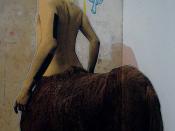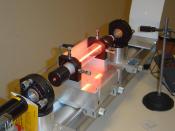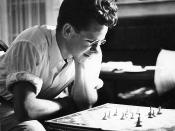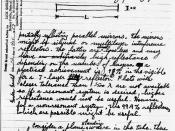LASERS Gordon Gould is the inventor of the Laser. He came up with the name LASER (Light Amplification by Stimulated Emission of Radiation). He invented the laser in 1957 but failed to get a patent. He had everything written in his notebooks and had it notarized, thinking it would be safe until he came up with a working model. He spent many years fighting in court to get credit for his work.
Gould was born in New York City, on July 17, 1920. He graduated with a degree in physics. He worked for the United States on the Manhattan Project, building an Atomic bomb during World War ll.
At the same time that Gould was working on the stimulated emission of radiation at Columbia University in New York , another man, Charles Townes, was also working on it. But it was Gould who thought of adding an optical resonator to a tube that has mirrored ends.
This was the way to make amplified light. Another scientist Theodore Maiman was the first to demonstrate a laser. He applied for the patent and got it even though it was Gordon Gould's idea. Gould didn't think he could get a patent until he had a working model so he took his notebook with all his ideas about the laser and had it notorized. He wanted to get credit for the laser and have the patent for it so with the help of an investor, who paid legal fees, Gordon Gould was finally able to win his legal cases in 1977 and given ownership of the laser patent. In 1978 he was named Inventor of the Year.
Lasers are many different sizes. They can be as large as a football field or as small as a grain of salt.
The laser has three main parts.
1. An energy source- Lasers often use electricity, another laser or a flash lamp as its supply for the energy source 2. An active medium- This is a material that can be made to create laser light. Gases, liquids or solids can be used. The active medium absorbs energy, stores it and releases the energy as light, triggering other atoms to release their energy.
3. The optical cavity, or covering of the active medium. Mirrors are at the ends of the optical cavity that reflect the light back into the active medium. One mirror has a fully reflecting surface, and the other is only partially reflecting. The reflected light causes more atoms to give off light. The light keeps getting stronger until some of it escapes through the partially reflecting side as a visible laser beam.
There are four main kinds of lasers. There are solid- state lasers, semi-conductor lasers, gas lasers, and dye (liquid) lasers.
The first solid state laser used a ruby rod. The ends of the ruby rod were cut flat, polished, and coated with mirrors to form an optical cavity to reflect light. Light was emitted from a flash lamp that was coiled around the tube. When light was pumped into the laser a powerful beam of red light was made. Garnet, neodymium, and other artificial crystals have also been used. The world's most powerful laser is the Nova laser. It is as big as a football field. It is used for nuclear energy research.
In a liquid laser the rod is replaced by a container of solution like neodymium oxide or chloride in selenium oxychloride.
Semiconductor lasers use materials that conduct electricity but do not conduct it as well as copper, iron or other true conductors. These are the smallest type of laser and are the most commonly used because they are smaller and lighter and use less power than the other kinds.
Gas lasers use a gas in a tube as the medium. The most common is carbon dioxide. It is the most efficient and powerful laser. The atoms are excited by the electrical current. They are used in communications, eye surgery, entertainment, holography, printing and scanning. They can also be used to cut and weld metal.





